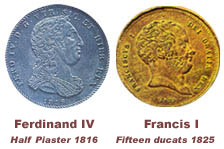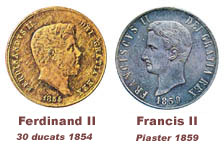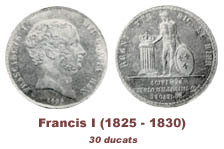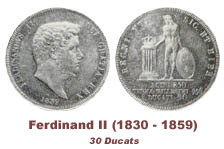Coins
When Charles of Bourbon ascended the Throne of Naples in 1734, the basic monetary unit was the ducat [(La monetazione napoletana da Carlo a Francesco II di Borbone (1734-1860), by M. PANNUTI, edited by the Gaetano Filangieri Museum, Naples 1975)], a silver coin weighing about 22 grammes and containing 9/10 of pure silver and 1/10 of an alloy(copper). The ducat was divided into 10 carlins, each one in turn divided into 10 grains, and each of these into 12 horses.
There were also gold ducats, although new gold ducats had not been minted since 1649.
The monetary system during the rule of Charles of Bourbon
Concerning gold coins, soon after ascending the Throne, Charles continued the minting of small gold coins in Sicily as it had been made in the past, but in Naples he preferred to mint multiples of the gold ducat, due to the huge increase of the gold/silver ratio (1 to 14½) in comparison to the past. He minted ducats with a face value of 2, 4 and 6, at the title of 21¾, i.e. about 906 thousandths of pure metal.
The 6-ducat coin was also called Neapolitan uncial to differentiate it from the Sicilian unciae, since the latter had half of the weight and therefore half of the value of the Neapolitan unciae. Gold coins were minted from 1749 to 1756.
He also continued to mint large silver coins: the piasters (gr. 25. 61) which were worth 12 carlins, or 120 grains, and their half-value coins where an inscription reads “De Socio Princeps” (“From Allied to Sovereign”), a clear reference to the fact that with Charles the Kingdom of Naples – once “Habsburg Vice-royalty” and “Spanish Province” – had become an independent and sovereign nation from all points of view.
These pieces, with a fineness of about 900 thousandths, were minted from 1734 to 1736. In 1747 a commemorative minting was made for the birth of the first son, Prince Philip: two artistic coins were minted – one piaster and half piaster – showing the heads of Charles and Maria Amalia on their obverse, and a sitting woman with a child on her right arm on the reverse. Their boarding bears the inscription “Firmata Securitas”, to stress the certainty of the family descent and therefore the independence of the Kingdom.

Until 1749, piasters and half-piasters bearing the inscription “De Socio Princeps” were minted, whereas from 1750 they showed the right side of the bust of the sovereign.
We must also mention carlins and half-carlins, worth 5 grains, popularly called “cingranella”, showing on their reverse the Goddess of Plenty depicted as she was scattering coins.
Concerning copper coins, the minting included the “public” or 3 tournois coin, the grain or 12 horses, the 9 horses coin, the tournois or 6 horses, the 4 horses and three horses coins.
The monetary system under Ferdinand IV
Due to the very long reign of this sovereign, the minting is vast. According to the historic phases of the king’s life, three periods are detected.
In the first, longest, peaceful and rich phase (1759-1799), Ferdinand continued the gold minting started by his father and issued coins valued 6, 4 and 2 ducats with the same title and weight (21¾ carats) set by Charles.
The minting of gold coins continued until 1785 and many coins were minted, more than 3 million pieces. The sovereign is depicted in various attitudes and at different age, from his childhood to his manhood.
Concerning silver minting, the first coin was a half-piaster coin minted in 1760 and also called “pupillare” (at that time Ferdinand was just 9 years old). Then two coins were issued depicting the sovereign in his prime (1766 to 1767), and after them a coin in 1772 to commemorate the birth of his first child Maria Teresa, showing the heads of Ferdinand and Maria Carolina on its obverse and a sitting woman with a baby on her lap on its reverse. On the background, the Sebeto, the Vesuvius and the sea with a vessel; in the boarding, the inscription “Fecunditas”.

Other two commemorative piasters were minted in 1791, to commemorate the trip to Austria made by the Sovereigns who accompanied the two princesses Maria Teresa and Maria Louisa, future brides of the Archdukes Francis and Ferdinand, sons of Grand Duke Leopold.
The first coin, a rarity, shows on its obverse the heads of the sovereigns and on its reverse the Sebeto and Parthenope depicted as she was making a sacrifice on an altar. On the background, the Vesuvius, on the boarding the inscription “Pro Fausto Reditu P.P. Vota Soluta” (votive offering made for a safe return of the sovereigns).
The second coin shows the same picture on its obverse, but its reverse shows 4 signs of the zodiac (Libra, Scorpio, Sagittarius and Capricorn), which are zodiac signs after the departure of the sovereigns.
These two piasters, as all the subsequent pieces (piasters, half piasters, ducats and half ducats, tarì and carlins) were minted with a fineness of 833/1000, which means that they contained 5/6 of pure metal and 1/6 of alloy, and therefore they were less “worth” than the previous ones.
Before the events of 1799 (the flight of the Court from Naples to Palermo after the Napoleonic invasion which led to the Neapolitan Republic) some piasters were minted bearing the year 1799, and the minting was resumed in July when the sovereigns came back to Naples.
Concerning copper coins, the minting set by Charles was continued. In the ‘90s, three new coins multiple of the grain were minted: a 10 tournois coin (5 grains), a 8 tournois coin (4 grains) and a 5 tournois coin.
In the second period of his Kingdom (July 1799-1806), Ferdinand minted silver piasters with the thousandths 1799, 1800 and 1802, and therefore 1804 (very rare). Finally in 1805, he minted an artistic piaster and an half piaster. For the copper ones, he eliminated the 10, 8 and 5 tournois coins and minted 3 and 2 grain coins, i.e. 6 and 4 tournois coins bearing the portrait of the Sovereign, and also the grain of 1800 «A singularly rare coin», says Pannuti (Ibidem, p. 10), the 9, 4 and 3 horses coins.
The coins minted in 1805 were the last to bear the initials of the minting master.
In the third and last phase of his kingdom (after the fall of Murat), Ferdinand immediately minted a beautiful piaster, a carlin and an elegant and rare half piaster.
In 1816, a 8 tournois and a 5 tournois were minted in copper, «with a better and more distinguished design, shape and weight» [Ibidem, p. 11].
When the two kingdoms of Naples and Sicily were unified and became a single Kingdom (of the Two Sicilies), on 20 April 1818 a law was issued abolishing the legal ratio among coins produced with the three different metals. This law ruled that the basic monetary unit was the silver ducat, equal to 22.94 grammes and a fineness of 833/1000, which means 5/6 of pure metal and 1/6 of alloy. Future gold coins would be just fiduciary currency and had to be minted with almost pure gold, precisely a title of 996/1000. Nominal value was also recognised to coins introduced by the Neapolitan Republic and by Murat. Then for the first time three beautiful pure gold coins were minted.
Concerning silver coins, the minting included piasters, half piasters, a very rare tari and a carlin, all showing the thousandth 1818 to comply with the above mentioned law.
Concerning copper coins, the minting included a 10 tournois coin, or 5 grains «Big and beautiful coin». [Ibidem, p. 12], a 8, 5, and 4 tournois coins and a one tournois coin, with very rare variants.
The monetary system of Francis I

He continued the gold minting of ducats: 30, 15 (very rare), 6 and 3. The 6 and 3 ducats show on their reverse the winged Bourbon genius. The silver minting included the piaster, half piaster, tari and carlin. In copper, the 10 and 5 tournois and the tourneys, and the grain after 25 years.
The monetary system of Ferdinand II

Almost every year of his kingdom, he minted gold coins (56), silver coins (125 among piasters, half piasters, taris, carlins and, from 1836, the half carlin coin) copper coins (7 different coins among which 10, 5, 3, 2 tournois and the tournois and half tournois), and also added other nominals to those issued by his predecessors.
The monetary system of Francis II
During his brief reign, he did not mint any golden coins because of the exasperating length of the incision works of the minting masters. However he did mint two silver coins (a piaster and a tari), and 10 and 2 copper tournois coins.
During his exile in Rome, he continued the minting of coins to stress his sovereignty: produced 10 tournois coins slightly different from past ones.
As M. Pannuti said, «These pieces, though they were forgery, cannot be considered faked, since they were minted by order of the sovereign, though he had been deposed» [Ibidem, p. 13].





